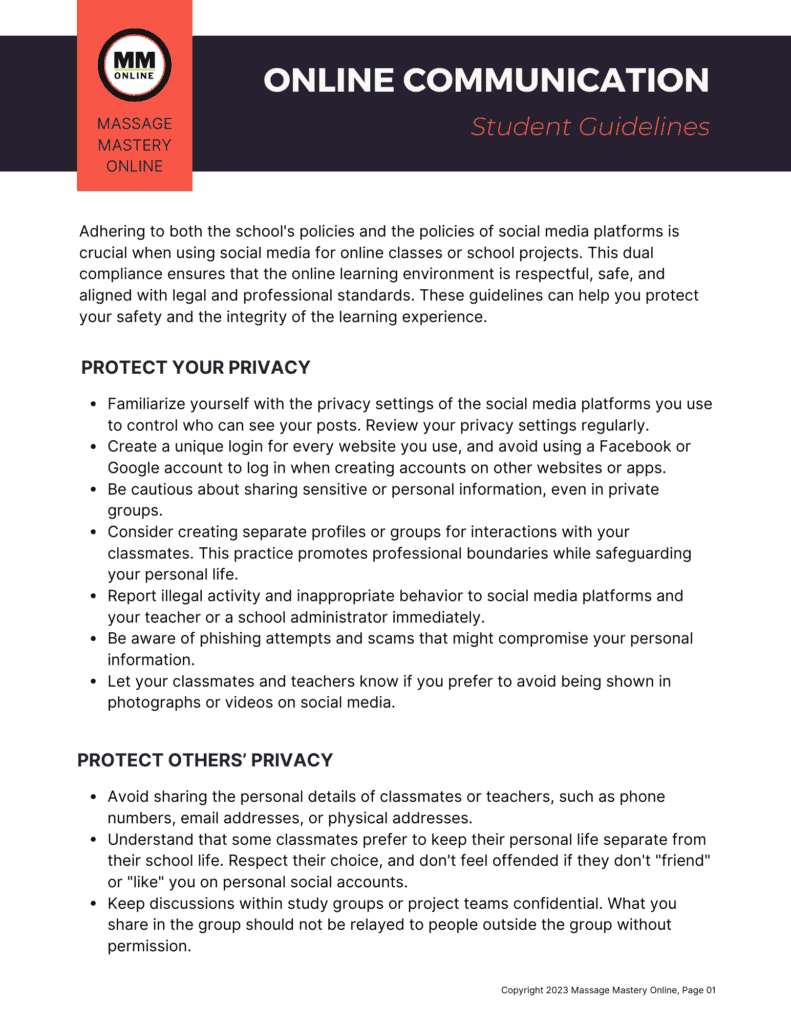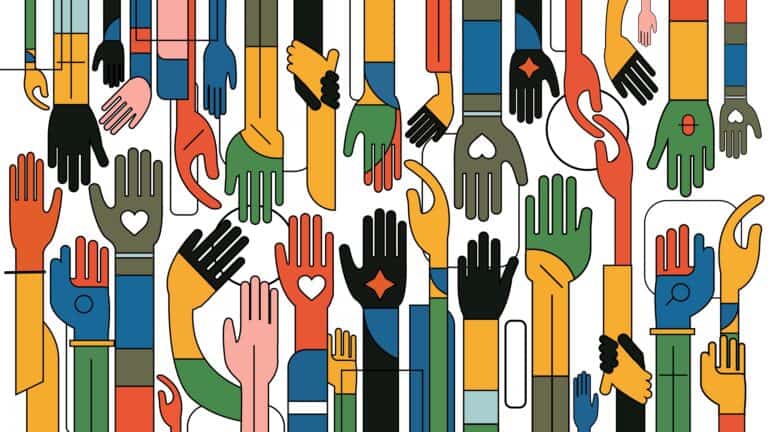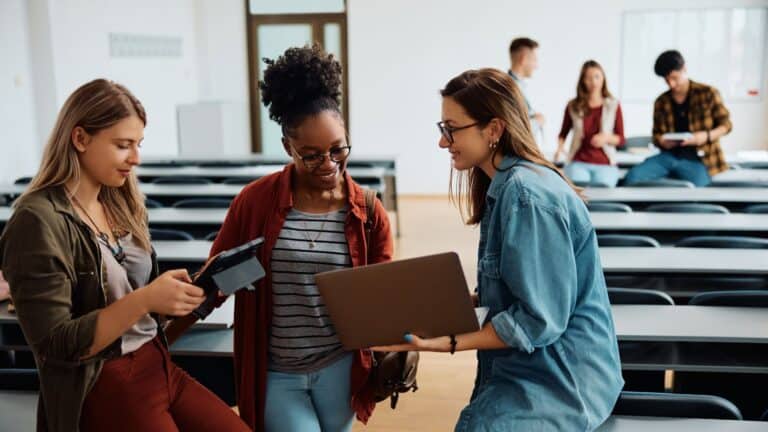An Introduction to Social Media in Massage Classrooms
In today’s digital age, an overwhelming 90% of U.S. adults use social media on their mobile devices daily. Leading the pack is YouTube, boasting a staggering 197 million U.S. enthusiasts. Hot on its heels, Facebook garners attention with 190 million dedicated users. While Instagram (140 million), LinkedIn (80 million), and Pinterest (90 million) might not match the giants in sheer numbers, their unique functionalities make them invaluable for specific classroom activities.
The majority of adult learners are no strangers to these platforms and they understand how they function. This intrinsic familiarity, combined with the unparalleled accessibility and immediate nature of social media, positions it as a potent tool for information dissemination and fostering peer collaboration. However, you’ll want to make sure that students have clear guidelines for communication in online environments. Download these guidelines developed by Massage Mastery Online and use them as they are or adapt them for your program.
In this article, we’ll investigate the benefits and drawbacks of using social media in our classrooms. Then, we’ll talk about two ways to get started with Facebook Groups. Search for other blog posts at Massage Mastery Online that explore different aspects of social media for learning. These topics inspire creative thinking about our current lesson plans and new ways to enhance learning.

The Benefits of Using Social Media in Adult Learning
Learning management systems, discussion boards, digital forums, peer-review software, and online collaborative whiteboards are often valuable but expensive education tools. Social media is free and offers sustainable learning options with many benefits:
Accessibility and Immediacy: Social media is accessible anytime and anywhere, allowing flexible learning schedules and immediate responses to questions. If students are confused about an assignment, they can ask for clarification via social media and receive a quick response well before the next class meeting.
Lively Discussions: Group discussions on social media are often more engaging and livelier than discussions on message boards or learning management system (LMS) forums. Students are often on social media and so contribute more regularly to the conversation. Additionally, introverted students can carefully choose their words and edit their input, so it feels safer to share.
Collaboration and Critical Thinking: Collaborative projects find the perfect home on social platforms because students can add different media types, including images, infographics, videos, pins, links, quotes, and comments. The dynamic variety of materials students can contribute inspires a treasure-hunt mentality as they forage the Internet for interesting contributions. So long as teachers provide thoughtful guidelines, adult students are capable of spotting and correcting faulty or inappropriate content, leading to improved critical thinking and Internet research skills. Students are more likely to fact-check when they know their inputs will be viewed and critiqued by peers.
Student-Centric: While teachers should monitor any activities conducted on social platforms, projects tend to be student-driven. Students encourage and critique each other and actively revise content through discussion, debate, and compromise. Teachers empower positive interaction through praise and only intervene to correct flawed thinking or improper content.
A Living Resource: In some cases, a teacher may choose to have a current class build off the findings and contributions of previous classes. For example, a teacher might use the same Facebook Group for all their classes on the same topic. Current classes can view the work of previous classes and compare and contrast their outcomes. Similarly, an instructor might invite their class to view a particularly inspiring Pinterest board as an example of excellent work.
Improved Digital and Communication Skills: Participating in social media-based projects familiarizes learners with online etiquette, digital collaboration tools, and content creation. Because classmates and future classes view their comments and contributions, students make an effort to correspond thoughtfully, enhancing their communication skills.
Community and Networking: Social media fosters community among learners with shared interests or goals. It provides a platform for mentorship, support, and shared experiences. LinkedIn is beneficial for expanding one’s network and allows students to form connections in massage therapy beyond school.

The Drawbacks of Using Social Media in Adult Learning
Social media is a powerful tool requiring teachers to think carefully about platforms, assignments, and the safety of students. We minimize the drawbacks of social media in learning by planning carefully structured student guidelines and projects. Here are some issues to consider as you develop activities:
Accessibility: Students with hearing or vision impairments may have more difficulty engaging with social media. Ensure guidelines for students encourage video captions and descriptive text for images.
Distraction and Time Management: Working on a learning task on a social media platform requires focus. Some students may switch between learning and personal social media interactions, meaning study tasks take longer. Similarly, the infinite scroll nature of many platforms can lead to unintended prolonged use, distracting from the primary learning objective.
Privacy Concerns: It’s crucial to design projects to protect the privacy of students and student clinic clients. Without clear guidelines, learners may inadvertently share sensitive or personal information.
Potential for Misinformation: Not all information students share on social media is accurate, which can lead to the spread of misinformation. While teachers can give students directions to fact-check their contributions and offer respectful critique to classmates, teachers must promptly intervene to correct flawed thinking or improper content.
Negative Interactions: The anonymity offered by the Internet can sometimes embolden negative behavior. Differences in opinion can escalate into unproductive arguments or disputes. Teachers must be ready to mediate should the discussion undermine learning goals.
Technology Dependency: Connectivity problems, platform outages, or device malfunctions can disrupt the learning process. Additionally, not every learner has equal access to devices or high-speed Internet, creating disparities in learning experiences.
Mental Health Concerns: Some students may experience “comparison syndrome” when seeing others’ contributions or achievements. Comparing oneself to others can lead to feelings of inadequacy and lower self-esteem.
Authenticity: Content on social media often portrays a polished or edited version of reality, which may not reflect genuine experiences or knowledge. Additionally, there’s a risk of students using or copying content without proper citation.
Monitoring: While social media-based projects are often student-driven, they require ongoing attention from teachers to ensure content and interactions are helpful, correct, and appropriate.
While these drawbacks highlight the potential challenges of integrating social media into adult classrooms, they also emphasize the importance of informed, intentional, and structured use to harness the platform’s benefits while mitigating its pitfalls.

Example Assignments Using Facebook Groups
While there are several platforms teachers might use to enhance learning, Facebook Groups offer teachers an easy entry point for getting started.
Private Facebook Groups create a closed and safe environment for learners and can be particularly beneficial for students who might feel hesitant to ask questions or share their experiences. Additionally, Facebook Groups accept an array of content types, allowing group members to post in formats they find most interesting. At the same time, hashtags make it easy to find content related to specific projects. If you’re new to using social media for education, Facebook Groups is an excellent place to start.
A Collaborative Research Project Using Facebook Groups
This collaborative research project uses Facebook Groups to investigate, discuss, and present contemporary trends, developments, and debates within a specific subject area. For this discussion, we’ll imagine that the title of the project is “Trends in the Use of Tools in Massage Therapy,” but the subject could also be “The Integumentary System,” “The Shoulder Region,” “Professionalism,” “Massage Systems,” or anything else.
Directions:
- Topic Selection: Divide students into smaller teams. Assign each team a specific trend or topic within the subject area. For example, one team might research the history and rise of tools, while another investigates the pros and cons of using tools, another the popularity of cupping, and another the use of percussive guns.
- Choose Hashtags: Give the project, each team, and each team member a unique hashtag. Ask students to add these hashtags in their captions whenever they make a post. For example, a hashtag system might include #toolsinmassage #teamhistory #julie.k or #toolsinmassage #teamcupping #matt.z. This way, students and teachers can use the search function in groups to find all the posts related to the project, a team, or a team member.
- Posting Phase: Over a set period (one week, two weeks, the entire term, etc.), ask each group to make between 3-5 posts sharing information about their topic each week. Posts should come from different group members (you don’t want one person doing all the work for a team). Contributions can include images with descriptive captions, survey questions, research articles, video presentations, videos with captions, and other appropriate content. Team members work together to determine their posts each week and to ensure their content comes in varied formats.
- Comments and Critiques: During the posting phase, require each student to comment on the posts of a specified number of members from other teams using thoughtful and respectful language. Note that “liking” a post or sharing emojis is not enough. Encourage students to add information or resources (e.g., a related image or research study), ask questions, or challenge the validity of information with referenced facts or links to research articles.
- Summary Phase: As a final post, ask students to make a short video summarizing their findings and incorporating the feedback and comments they received from peers and post it to the group. Other groups provide feedback, ask questions, or discuss the implications further.
- Reflection: To conclude the project, hold a class discussion or Zoom discussion to explore overarching themes, surprises, or insights gained from the project. Include discussion questions that ask students to reflect on ways they deepened their research skills and improved their collaborative communication.
- Grading: There are several ways you might grade students on a project like this. You might assign points to the project and determine a minimum number of posts and comments for an A, B, C, or D. If the project is an important one comprising a significant portion of a student’s grade, you may wish to judge the thoughtfulness of each student’s posts and feedback and give it a point value from zero (poor quality) to five (excellent quality). Use hashtags to identify all the posts of an individual student and grade the quality of each post. Use the screen capture function on your computer to generate images of each student’s work for grading purposes.

Support for Classroom Content
Some teachers use Facebook Groups as ongoing support for brick-and-mortar or online classrooms. Think about incorporating these ideas:
Announcements and Reminders: Teachers might use Facebook Groups to post assignment announcements or reminders for upcoming exams. When you post sample quiz questions or links to example work, students view Facebook Groups as a hub that helps them stay apace with course happenings. Similarly, teachers can post schedule changes based on weather events or other disruptions.
Questions and Answers: Facebook Groups provide a flexible way to address student queries. Students can offer clarity or support until an instructor can address a student’s questions. Dedicated Q&A threads promote deeper thinking on specific topics.
Sharing Supplementary Resources: As teachers and students come across resources that benefit the class, they can share them with the group. Posting articles, videos, podcasts, images, and other materials relevant to the course encourages students to delve deeper into topics at their own pace. The longevity of posts in Facebook Groups allows students to view the resources, discussions, and supplemental material from previous classes, aiding their understanding of the subject matter.
Thoughtful Discussions: Each week, instructors can post a topic for discussion and require students to give input on the topic and the contributions of their classmates. This process ensures everyone in your class has a voice and improves writing and communication skills. Furthermore, often classroom and online course discussions are constrained by time limits. Teachers can use Facebook Groups to continue these discussions outside of class, giving students time to reflect and contribute thoughtfully.
Feedback on Course Content: Often, there is little class time for students to share their feedback on course content or suggestions for classroom activities. Using feedback threads or links to survey questions encourages constructive feedback that can help teachers adjust educational activities or respond to the needs of a particular cohort.
In Closing
In closing, we’ve discovered that when thoughtfully integrated, social media platforms can bridge the gap between traditional classroom learning and the digital world, offering students a creative, interactive, comprehensive, and engaging learning experience.


